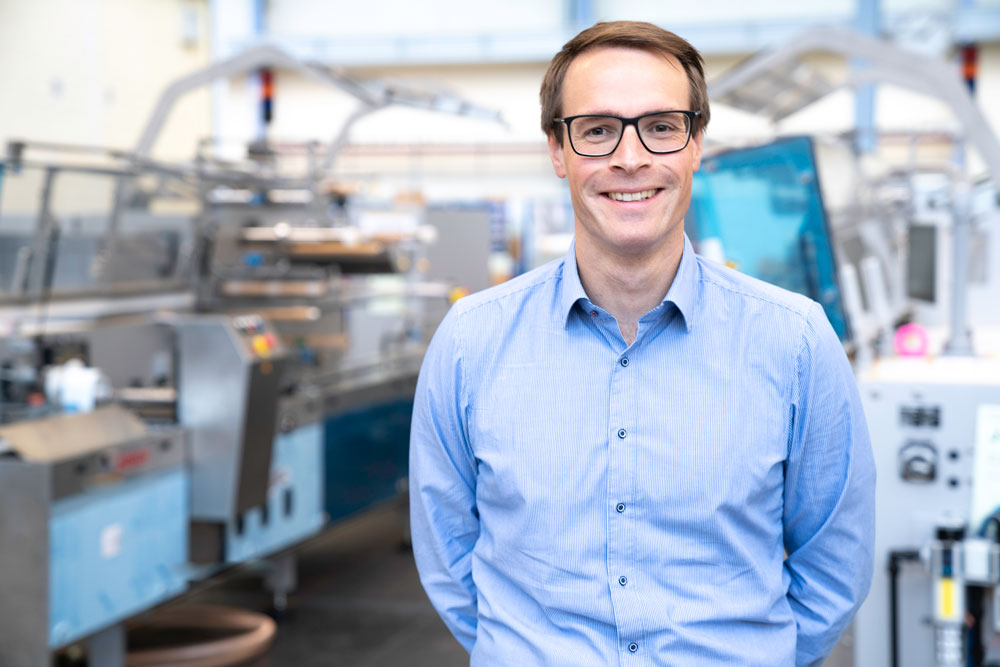Christoph Langohr, of Syntegon, Gives Sustainability Update at PACK EXPO Connects

With deadlines toward a circular economy quickly accelerating over the next few years, companies continue to innovate by trying different techniques, including offering paper packaging as an option.
During a presentation at PACK EXPO Connects that was held virtually Nov. 9 to 13, Christoph Langohr, project manager sustainability horizontal flow wrapping with Syntegon, gave an overview of what Syntegon has developed. Langohr first laid out the underlying issues, pointing out that sustainability is a global challenge, and a deeper look into the United States shows that the recycling rate for plastic waste is about nine percent and noting that the equivalent of 65 trash trucks of plastic per day is dumped into the ocean.
“Another study shows us that American millennials perceive that plastic pollution is a real threat,” Langohr says. In fact, studies show that 74 percent of consumers are willing to pay more for sustainable packaging. “All these facts and figures show us that sustainability is a really important topic, and we at Syntegon care about the topic.”
The drivers for change include food production companies that can enhance their image with sustainability efforts, while government regulations and awareness from retailers and consumers also drive efforts. Regardless, packaging must meet various criteria, including those for storage, loading and transport, presentation and image, product information, and product protection, Langohr points out. He said product protection is the primary concern when it comes to innovation.
In 2016, the European Union developed the waste hierarchy that included avoidance at the top and then reusability, recycling, recovery, and disposal. Langohr notes that the waste hierarchy provided two main options for packaging:
- Avoidance, which involves using thinner layers of packaging materials or optimizing the package sizes.
- Recycling, which means that materials are used after the initial use in another way. It can involve designs that focus on mono-materials but also paper.
“We see a huge market demand for paper packaging,” he said, adding that paper is among the most challenging materials to work with.
The company found that, among the many challenges, there were several main questions: What is the right material? What impact does changing the packaging materials have when switching to paper packaging? What does the transition process look like? And how is risk minimized?
The answer to the material question depends on the product, its shelf life, and ensuring that the product is protected. When it comes to sustainability, another important factor is the region where the product will be distributed because recycling systems vary. What might work in Asia might not work in the United States. “This is really one of the most important factors of sustainable packaging,” Langohr says.
When considering a change in packaging, customers often are concerned about the loss of product quality and the negative impact that can have on a brand’s image. They also are concerned about the lower output rates from reduced packaging speeds and increased downtime from machine stops. But those concerns can be addressed, Langohr says.
The company started with solutions for the flow wrapper and saw the need in the secondary packaging to protect the barrier layer of the flow wrap during the production process. Those challenges required production lines with different machining, such as forming parts and sealing tools for the flow wrapper and gentle carton loading processes.
The transition process includes a multi-step approach that minimizes risks for food producers, starting with an analysis of what the producers need, followed by feasibility studies and machinability tests, he said. The final steps include creating the machines for the product lines and production.
Customers can review progress at every step to assess whether more testing is needed or whether they want to proceed.
“I think this is a very good approach,” he said, adding the review process helps minimize risk for customers who can opt out at any point along the way.
Even though the path to a circular economy is dynamic, the goal is to make the production lines future proof, so that the machines can be in place for decades, he added.
One Syntegon customer has been Mondelēz International that wanted to package Cadbury chocolates in fully recyclable paper flow wraps. Another was Nestle that wanted to transition the SMARTIES bar to paper packaging too, he says. Syntegon Systems AG is based in Switzerland and has more than 6,100 workers at 30 locations worldwide, according to the company website.
Thomas A. Barstow is senior editor of FlexPack VOICE™.


